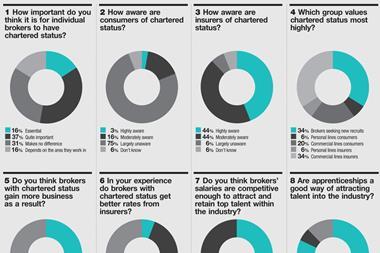
Apprenticeship schemes have always helped encourage young talent into the industry, even though many more 18-year-olds opted for university during the Labour government years. Today, the rise in the cost of studying for a degree means that more school leavers are opting to go straight into the job market rather than going on to higher education.
Bluefin Corporate account broker Zoe Smith came through Bluefin’s apprenticeship scheme after finding out about it through a friend.
She says: “To people considering doing an apprenticeship now, I’d say definitely go ahead and do it. Previously I wasn’t really aware of commercial insurance, but after coming through the interview and being told what sort of areas I’d be working on and what type of clients I’d be working with, I thought yes, it’s something I’d really like to get involved in.
“The fact that I could study and get exams at the same time as I was working was brilliant, and Bluefin put me through the exams and provided me with a mentor.
“I’ve got the certificate and I’m applying to do the diploma now. The qualifications always put you in a better position in terms of your career and the extra knowledge really gives you confidence.”
Top three trends:
1. Pay and benefits
Remuneration across financial services has been scrutinised, while benefit packages improved.
September 2006: Gender gap closing
Women received higher pay rises than men for the 10th consecutive year, though greater numbers of women continued to leave the industry.
February 2008: Prudence pays
The ABI warned against making undeserved payment to failed executives both in terms of contracts and severance deals.
December 2009: Insurer pay unregulated
The FSA announced that it will not extend its remuneration code to regulate top insurers’ pay, though banks’ and brokers’ pay must be linked to projected risk
and results.
January 2010: Bonus supertax
A new so-called ‘bonus supertax’ of 50% was introduced on City bonuses of more than £25,000, causing the ABI to warn brokers against big bonus payments.
May 2012: Ward’s pay rise
Lloyd’s chief executive Richard Ward received a 20% salary rise, even though the corporation lost £516m in 2011.
2013: What’s next?
After the Aviva debacle, industry boardroom pay will continue to be closely scrutinised.
2. Young blood
As university fees increased, the industry has renewed focus on apprenticeships and training.
September 2005: Home-grown talent
Skills shortages drove brokers to increase in-house training. Coversure announced a £60m apprentice scheme, while 45 of Higos’s 120 staff were reportedly products of its apprenticeship scheme.
December 2006: CII targets youth
With the number of school leavers going into insurance falling, the CII stepped up its campaign to attract younger talent, as well as doing the usual rounds at universities.
April 2007: Swinton recruits
Swinton started a new apprentice scheme training young recruits in CII NVQs, with a view to filling the skills gap in commercial insurance.
March 2008: Degrees devalued
The CII’s Caspar Bartington claimed that insurers were starting to value university degrees less and that school leavers were now more attracted by apprenticeships.
February 2009: Apprentice bill boost
A Labour bill boosted the number of apprentices. Yet many employers remained unaware of the part that professional qualifications could play in such government-funded schemes.
July 2010: Co-op’s £9m academy
The Co-op invested £9m in an academy for 2,000 apprentices across all sectors including insurance.
April 2011: Aon apprentices
Aon’s new apprenticeship scheme attracted 200 applicants for just 12 places.
January 2012: Lloyd’s gains apprentices
Lloyd’s Market Association chief executive David Gittings said managing agents were hiring more trainees as universities priced out
the young.
2013: What’s next?
Apprenticeships are here to stay as more firms see the benefit of training bright school leavers.
3. Senior talent
Who has replaced whom in the top jobs within the industry?
October 2005: Lloyd’s loss
Nick Prettejohn stepped down as Lloyd’s chief executive amid a fearsome hurricane season, to run the Pru’s life assurance business in the UK and Europe.
November 2006: Commercial recruIting
Charles Earle, who had left NIG, set about recruiting an 80-strong team for a new commercial lines operation, luring many former colleagues to join him.
December 2007: Staff exodus
Troubled property services group Erinaceous lost 22 insurance staff, including 14 to Towergate, in the year it breached debt covenants and issued a profits warning.
June 2008: Gallagher hires
A team of 18 left Heath Lambert’s global business solutions unit, to join arch rival Gallagher for an undisclosed sum. The move followed similar transactions for
Heath Lambert.
August 2011: Gallagher swoops
Oxygen’s 21-strong London market team joined Gallagher.
May 2012: Moss out at Aviva
Andrew Moss quit as Aviva boss after shareholders rejected the directors’ pay strategy. Chairman John McFarlane has started a cost-savings programme, which could cut 800 jobs.
2013: What’s next?
A new generation of chartered professionals is rising up through the industry as future leaders.
Hosted by comedian and actor Tom Allen, 34 Gold, 23 Silver and 22 Bronze awards were handed out across an amazing 34 categories recognising brilliance and innovation right across the breadth of UK general insurance.













No comments yet